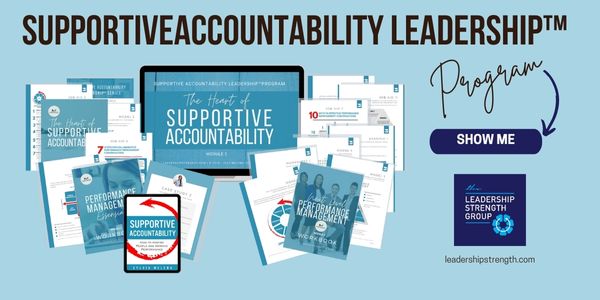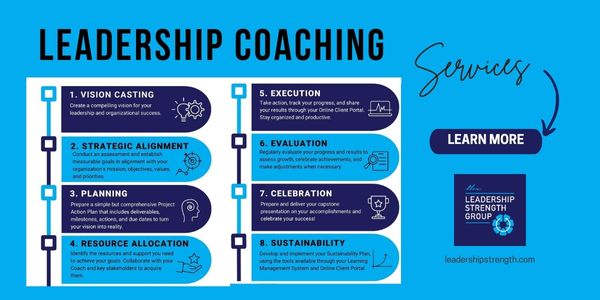Leadersip matters.
Strong leaders are the cornerstone of employee engagement, motivation, and organizational performance.
Building strong leaders takes a significant investment of time, energy, and commitment, but the rewards are huge.
Strong Leaders
Krüger & Rootman conducted empirical research on 400 small businesses. Their findings supported what many other researchers have concluded for decades: strong leaders are essential for employee satisfaction and commitment.1
Strong leadership have the desire, passion, and ability to proactively identify and support the needs of employees to achieve the intended results.
The Direct Supervisor is the Key
Strong leadership is crucial at every level of the organization. However, research has consistently revealed that the direct supervisor is the key to employee engagement, satisfaction, and commitment. This is true whether the supervisor is a seasoned executive or an entry-level supervisor.
Clinebell et al. cited the work of Yummarino and Dubinsky (1992) which asserts that the supervisor is one of the most important factors influencing employee attitudes about the workplace.2
What’s more, the leadership style of the direct supervisor significantly shapes the quality of the supervisor-employee relationship. For companies and organizations that want to create great workplaces, building strong leaders must be a focal point.
The Four Leadership Styles of Supportive Accountability™
“The Supportive Accountability Leadership Model™ frames performance management using four basic leadership styles determined by how much leaders strike a delicate balance between support and accountability. These four styles are depicted below based on high and low levels of supportiveness and accountability.”3

“Leaders can operate anywhere in the continuum between high and low for both supportiveness and accountability, and the amount of support and accountability required will vary from situation to situation.”4
- “Unsupportive Accountability is characterized by high levels of accountability and low levels of supportiveness. Leaders with this style demand high performance but don’t provide the necessary tools, equipment, and emotional support employees need to achieve it. This type of accountability can create a harsh, intimidating, and uncaring environment for employees.”5
- “Supportive Unaccountability is demonstrated by high levels of supportiveness and low levels of accountability. Leaders who operate with a high degree of supportive unaccountability tend to worry too much about being liked and making employees happy. They have difficulty holding themselves and their employees accountable for meeting organizational goals and priorities.”6
- “Total Avoidance is the absence of both supportiveness and accountability. This is a hands-off approach, where leaders relinquish their responsibility to lead, guide, inspire, and hold themselves and their employees accountable for meeting goals… Instead of getting ahead of problems, they operate in a reactive mode and only spring into action when fires erupt.”7
- “Supportive Accountability is the most effective performance management style. It embodies a high level of supportiveness complemented by a high level of accountability… Effective leaders provide the right amount of support and accountability based on each situation. When performance isn’t quite up to par, they don’t look for a person to blame, but rather seek to uncover the underlying causes and to provide the support necessary for success.”8
Strong leadership is paramount for creating an environment that motivates employees and promotes strong performance. Leaders that are highly engaged and proactive in their leadership roles are able to motivate and engage employees. On the contrary, leaders who are passive, avoid their
Strong Leadership is a Skill
The great news is that strong leadership is a skill that can be learned and refined over time. Companies and organizations that are serious about employee engagement and strong performance outcomes can deliberately hire, develop, and engage their leaders to create motivating, engaging, and high-performing work environments.

Selection
The most important step in creating a strong leadership team is to hire the right people with the right talent for the right roles.
Get this wrong and the rest will be an uphill battle. Get this right and, and while you’ll still need to develop them, it will be a much more rewarding experience for everyone.
Even if you already missed the mark on this important piece, it’s not too late to work with the leader to make it right. How this will unfold depends on each specific situation. It will take significant commitment, time, and energy, but the damage can be repaired.
Expectations
Get crystal clear on what you expect, and transfer this knowledge to your leadership team. What are your organization’s vision and mission? What are your values? What leadership approach do you expect? This is not about micromanagement. This is about establishing and continuously reinforcing a clear leadership philosophy for your organization.
What type of culture are leaders expected to craft, promote, and reinforce? What are each leader’s measurable goals, objectives, and deliverables? Last, but most definitely not least, what does your leadership team need and expect from you?
Talent Development
Think about the mindset and skills that are required to meet these expectations and map out a talent development plan to instill these into your organizational culture.
Depending on your goals, priorities, and capacity, you can leverage your existing training resources, develop additional internal training, or seek outside assistance. If you’re looking for an effective leadership training and development program, we provide some options.

Evaluation
Evaluate your leadership team’s progress in meeting the expectations and determine the appropriate course of action. Have individual and group conversations with your leadership team members and their employees. Observe their operations and get a feel for the environment.
Review performance data, customer satisfaction information, and other key performance indicators. Avail yourself of a variety of assessment tools to gather additional insights. However, keep in mind that data is only part of the picture. There is always a story behind the numbers, and knowing that story is essential to making an accurate evaluation. Getting input from the people on the front line is a good way to start understanding the story.
Feedback
Give and receive continuous feedback. The open, honest, and supportive sharing of information will help you build strong supervisor-employee relationships with the leaders you supervise. Having continuous conversations and interactions is an essential part of leadership development, yours and theirs.
This can include formal feedback conferences, informational conversations, quick huddles, and the use of technology to communicate. The important thing is to be accessible and to communicate effectively. Feedback, if handled properly, is a great tool for reinforcing what is expected and for building leadership muscles and confidence.
Support
Feedback is also an opportunity for you to discover the needs of your leadership team members and provide the necessary support to meet these needs. Whether the needs revolve around tools, equipment, guidance, or emotional support, it is vital to uncover them and do your best to meet them.
It is also important to communicate with your leadership team your progress in addressing their needs. If you run into roadblocks, be transparent and share that information as much as you are ethically able to do so; it will go a long way in building trust.
Accountability and Recognition
Accountability is a vital part of performance management. Likewise, recognition is a powerful tool for rewarding and promoting great performance. These two tools are also available for building strong leaders.
Continuous Improvement
Leadership is an ongoing journey that will never end. The moment leaders think they have mastered the art of leadership is the moment their continuous improvement and growth will end.
Great leaders are self-aware and continuously self-reflect, because human nature guarantees that they will make mistakes. We have all been there before, and we will be there again. The key is to learn from these mistakes and to commit to becoming stronger leaders because of them.
Developing strong organizational leadership takes time and effort, but the investment will yield high returns in terms of employee engagement, motivation, and tangible results.

SYLVIA MELENA is the Principal of Melena Consulting Group, a leadership and organizational development consulting firm. She is also the two-time international award-winning and best-selling leadership author of Supportive Accountability: How to Inspire People and Improve Performance and its Spanish translation, Responsabilidad solidaria: Cómo mejorar el rendimiento laboral por medio del apoyo.
REFERENCES: 1Krüger, J. & Rootman, C. (2010). How do small business managers influence employee satisfaction and commitment? Acta Commercii,10(1). pp. 59 – 72. Retrieved from http://www.actacommercii.co.za/index.php/acta/article/viewFile/114/114. Creative Commons License. 2 Clinebell, S., Skudiene, V., Trijonyte, R., and Reardon, J. (2013). Impact of leadership styles on employee organizational commitment. Journal of Service Science, 6(1), pp. 139-152. ISSN 1941-4730. Retrieved from: http://cluteinstitute.com/ojs/index.php/JSS/article/view/8244. Date accessed: January 20, 2017. doi:http://dx.doi.org/10.19030/jss.v6i1.8244. Creative Commons License. 3, 4, 5, 6, 7, 8 Melena, Sylvia. “The Heart of Supportive Accountability.” Chap. 1 in Supportive Accountability: How to Inspire People and Improve Performance. La Mesa, CA: Melena Consulting Group, 2018.







